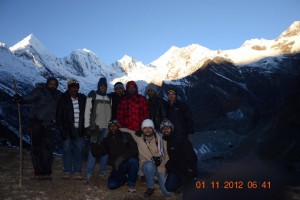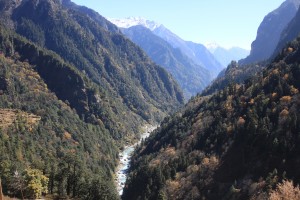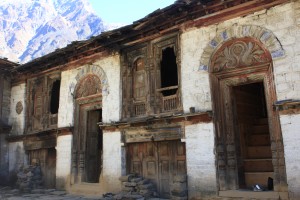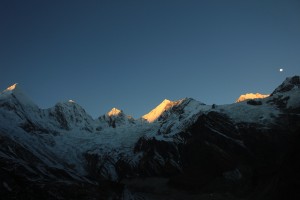THE PANCHACHULI EXPERIENCE
Located in a remote corner of the Himalayas in India, close to the border with Tibet, stand five prominent snow peaks in a row rising more than 20,000 feet into the deep blue sky. Their profiles are perfectly triangular and, being symmetrical in shape and size, they look rather like a child’s drawing of a mountain range.
The peaks are called Panchachuli by the villagers and locals who inhabit the densely forested valleys at its base – in the local mountain dialect, Panch Chuli means the five hearths.
These five peaks have been accorded meaning by Hindu legend as the five hearths on which the Pandavas [principal characters of the Hindu epic Mahabharata] cooked their last meal before ascending to heaven. The Himalayas, long considered sacred ground by the Hindus, was where the five brothers sought refuge after having lost their kingdom and their families to their warring cousins.
And it was to this land of legends in the state of Uttarakhand that I experienced one of my most memorable treks.
My Kailash Mansarover trek of June-July of 2012 acquainted me to the guide Arjun Singh, who informed me [knowing of my passion of footloosing] that a group of ten from Vizag had signed up for the Panchachuli trek taking place later that year in October. Well, needless to say I jumped at the opportunity.
My journey started with me boarding the Sampark Kranti Express train to New Delhi and on arrival boarding another locomotive to Kathgodam in Uttaranchal. After having rested my tired eyes at the KMVN Guest House, I woke up next morning and readied myself for a 10 hour drive to Dharchula.
To begin the trek we had to reach Dhar, which was another couple hours drive from Dharchula. Having reached around noon, we made our way towards Urthing – our first halt for camp. On the way, refreshments were made ready for us at Bongling. Having recharged our cells we carried on our 8 km trek.
En route, the scene of beautiful waterfalls and streams as well as their cool mountain dew [not the soft drink] sated the thirst of our minds and our parched throats. While we clicked photographs to keep memories of the magnificence of nature, our porters carrying supplies and kitchen utilities carried on ahead with minimum fuss so that we would be provided fresh piping hot food when we eventually reached camp. It is worth mentioning that usually rations are stocked up at various campsites from previous treks so that the porters do not have a lot of load to ferry up and down. Indeed a mark of good logistical management.
We reached Urthing at around 4:00 pm and later that evening we were happy snappers clicking pictures and posing with the Dhauli Ganga trying to get the best shot, perhaps for their Facebook profile [I know I did] Meanwhile, a delightful fare of rice, dal, potato sabji, papad and chapatti was awaiting us for dinner, which was later followed by sumptuous kheer for dessert.
Early next morning we were served breakfast of milk, corn flakes and parathas, as we set out for the next base camp at Nagling – about 8 km ahead. On the way, we crossed an ITBP (Indo-Tibetan Border Police) Check Post at Sela. Here we access to DSPT (Digital Satellite Phone Terminal) to call up folks back home as there is no cell phone connectivity high up in the mountainous terrain.
An uphill climb from Sela led us to our second camp at Nagling village. On arrival at around 2:00 pm, we were served welcome drinks by the chef. For dinner, chicken was made available; however, me being a vegetarian, I stuck with my dal and rice.
Now while one associates camping with pitching of tents, all the base camps for the Panchachuli trek provided us with a roof over our head in a makkaan or house. We were provided with mattresses and while the tents would surely be missed, there was no dearth of activity as we lit a bonfire, sang songs and danced the night away.
The entire village wore a deserted look as due to the onset of winter, most of the locals had moved towards the lower altitude settlements to brave out the cold season. Another significant piece of information I managed to gather from some of the remnant villagers was that the summer months of May and June help them earn their livelihoods which they can depend on for the rest of the year. Every summer they explore the region to unearth Ophiocordyceps sinensis locally known as yartsa gunbu literally meaning winter worm, summer grass. It is a fungus that parasitizes larvae of ghost moths and produces a fruiting body valued as an herbal remedy. The fungus germinates in the living larva, kills and mummifies it, and then the stalk-like fruiting body emerges from the corpse. It is known in English colloquially as caterpillar fungus. As it is prized as herbal medication, a kilogram of it can fetch one anything between $ 3,000 and $ 18,000. Only the villagers belonging to each particular area are permitted to benefit from their area findings and strict rules and regulations prohibit outsiders from taking advantage of the monetary gains.
The next morning we trekked on for another 9 km towards Sone. En route, we crossed the second ITBP Check post at Balling. Our IDs were checked as this region borders Tibet further on at Daabe village. We continued on and passed the village of Dugtu to finally reach Sone.
After spending the night, we woke up extremely early to leave for the Panchachuli view point. We reached at around 6:15 am after walking through snowy patches, just in time to see the sunrise. A majestic view of the sun rising from behind one of the 5 peaks and the moon setting below the other is a sight I shall never forget. The heights of these peaks are 6355 meters, 6904 meters, 6321 meters, 6334 meters and 6437 meters respectively and glaciers 3 kms long and 1 km wide project out from this range of mountains.
It was bone chilling, hand numbing cold which I had to brave to get my experience. But the view so exquisite, it was definitely worth it.
This is one trek that I would recommend to beginners as it is not that demanding on one’s stamina. The Govt. has already started to construct a road towards the Panchachuli base camp which has already passed Bongling. This will render the trek defunct in the coming years.
I feel privileged to have experienced this once in a lifetime trek and I urge you to hurry and get the feel of the trek before one can get easy access with the new roadway.
Till next time fellow gypsies!
Chief Gypsy… OVER and OUT!








